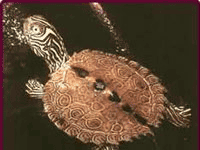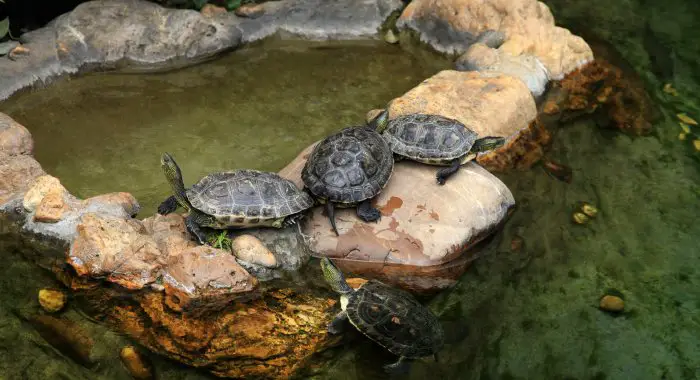Did you know there are dozens of terrapin types, each with its own preferences and characteristics? And yet, generally speaking, many people tend to look at taking care of a terrapin as being an easy job.
Certainly, the terrapins may not seem as involved and as responsive as some other common pets such as dogs or cats, but they are definitely not disposable; they also live, feel, and grow like any other pet and require as much care and attention.
One should be very aware of the kind of terrapin one owns so as to look after it well as different types of turtles may have different requirements, including habitat, food, and health or hygiene.
Therefore, before making any commitment, one should have knowledge of the different kinds and species of terrapins one can keep as a pet.
Box Turtle
 To begin with, the box turtle is the most common of all pet terrapins. These popular turtles are native to North America and Mexico, and they occupy a wide variety of habitats that vary on both a day-to-day and seasonal basis, as well as based on species (there are 7 species of box turtles).
To begin with, the box turtle is the most common of all pet terrapins. These popular turtles are native to North America and Mexico, and they occupy a wide variety of habitats that vary on both a day-to-day and seasonal basis, as well as based on species (there are 7 species of box turtles).
These terrapins are very small (only about 6 inches long) and thus easy to handle as pets. The box turtles resemble tortoises in appearance, and the male box turtles have longer tails than the females.
Box turtles are omnivores, meaning that they eat and have the ability to survive on both plant and animal matter. These little terrapins generally live close to the places where they were born, and they like to be out in the early morning and late afternoon sun.
Interestingly, box turtles hibernate in winter. Box turtles generally live for about 25 to 35 years but have been known to have lived for over 100 years!
Red Eared Slider (RES)
 The red-eared sliders are also immensely popular pet turtles and are so named because of the distinct red marks around their ears.
The red-eared sliders are also immensely popular pet turtles and are so named because of the distinct red marks around their ears.
Red-eared sliders are semi-aquatic creatures (living partly on land and partly in water) and are mainly found in the southern regions of the United States. However, the red-eared slider is actually native to the midwestern United States and northern Mexico.
A recent report claims that researchers have found some nests and eggs of red-eared sliders in the Southampton region of England but failed to find any hatchlings.
Red-eared sliders are of varied sizes – usually from about 5 to 12 inches long. As with many terrapins, the female red-eared slider terrapin is larger in size. They are generally found to breed near ponds and marshes.
Red-eared sliders are carnivorous (only meat-eating) as babies but attain omnivorous habits as they grow into adulthood. They are generally attractive in appearance and of a friendly nature. When cared for correctly, red-eared sliders can live for 20 years or longer.
Painted Turtle
 The painted turtle, which is widely found in North America – where it is the most common native turtle – is an aquatic (water-based) turtle, and as such is mostly located around marshes, lakes, and ponds. It thrives in slow-moving freshwater, from southern Canada to northern Mexico, and from the Atlantic to the Pacific.
The painted turtle, which is widely found in North America – where it is the most common native turtle – is an aquatic (water-based) turtle, and as such is mostly located around marshes, lakes, and ponds. It thrives in slow-moving freshwater, from southern Canada to northern Mexico, and from the Atlantic to the Pacific.
The painted turtle gets its name from the colorful and unique design on the bottom of each specimen’s shell; the turtle’s top shell is dark and smooth, without a ridge. It has a very hard shell, which it uses to hide in when the terrapin feels threatened.
Fossil evidence has shown that the painted turtle existed as long as 15 million years ago. The painted turtle grows to a size of about 8 inches and has an average lifespan of 30 years. This little terrapin has mostly carnivorous tendencies, eating mainly small water creatures including insects, crustaceans, and fish, but does also eat aquatic vegetation and algae.
Map Turtle
 The map turtles or saw-back turtles, like most terrapins, are also semi-aquatic and found commonly in freshwater. Map turtles are mainly found in Canada and the eastern United States. Map turtles are omnivorous but, in most cases, up to 70% of their diet is made up of insects, mollusks, and crustaceans.
The map turtles or saw-back turtles, like most terrapins, are also semi-aquatic and found commonly in freshwater. Map turtles are mainly found in Canada and the eastern United States. Map turtles are omnivorous but, in most cases, up to 70% of their diet is made up of insects, mollusks, and crustaceans.
These terrapins are called map turtles because of the creamy-colored markings on their neck, legs, and heads resembling a road map. The map turtles are small to medium in size and sexually dimorphic (females can be double the length and ten times heavier than males). And finally, map turtles can live for as long as 30 to 50 years.
Diamondback Terrapin
 The diamondback terrapin is found in the brackish waters (more salinity than freshwater, but not as much as seawater) of the southern and eastern United States of America. The diamondback terrapin is so named because of the distinct diamond pattern evident on its shell.
The diamondback terrapin is found in the brackish waters (more salinity than freshwater, but not as much as seawater) of the southern and eastern United States of America. The diamondback terrapin is so named because of the distinct diamond pattern evident on its shell.
The male diamondback terrapins only grow to about 5 inches in length and the female to about 7.5 inches. As carnivorous terrapins, they feed on crabs, small fishes, and mollusks. Diamondback terrapins have a long lifespan of about 25 to 40 years.
Would you love to adopt a terrapin?
If you would love to give a good home to a poor unwanted pet terrapin, we have provided a complete handbook on everything you need to know about looking after your very own pet terrapin – please check out the complete terrapin guide. Also, learn all about the legality of terrapin ownership and, of course, subscribe to our website for all news and terrapin-related information!

